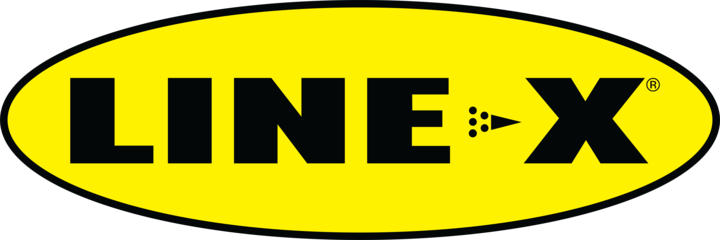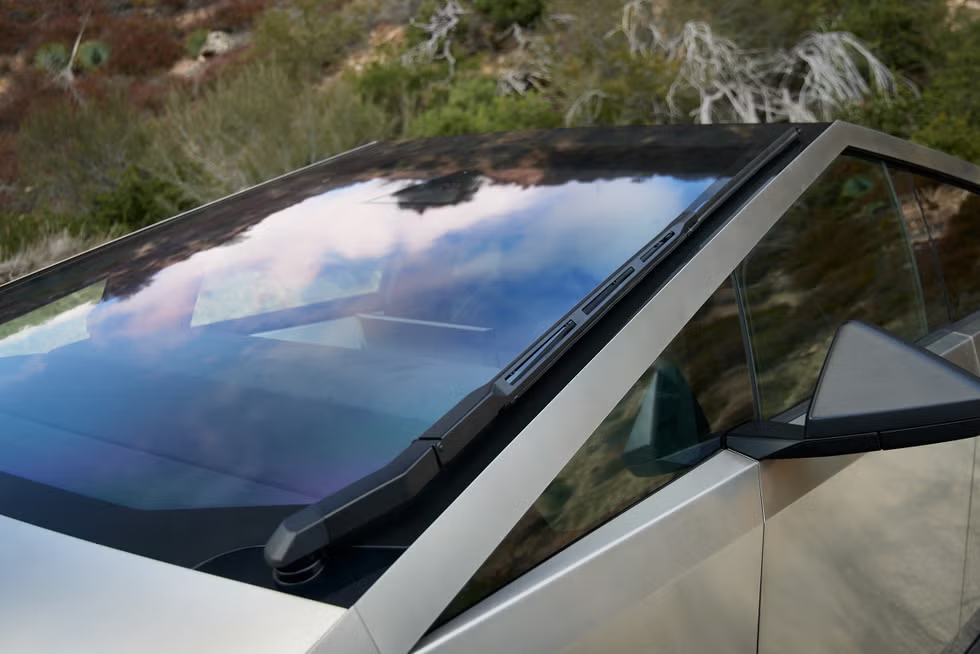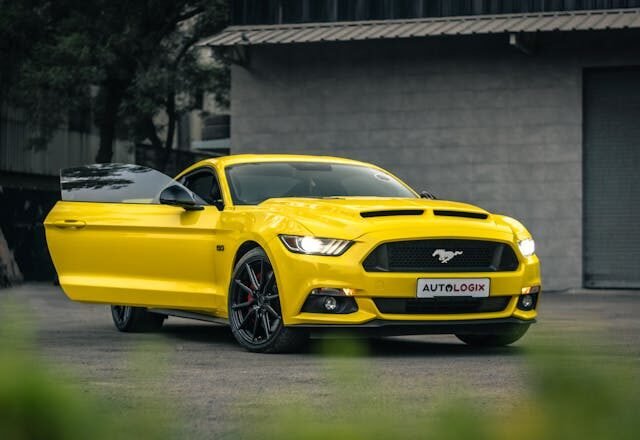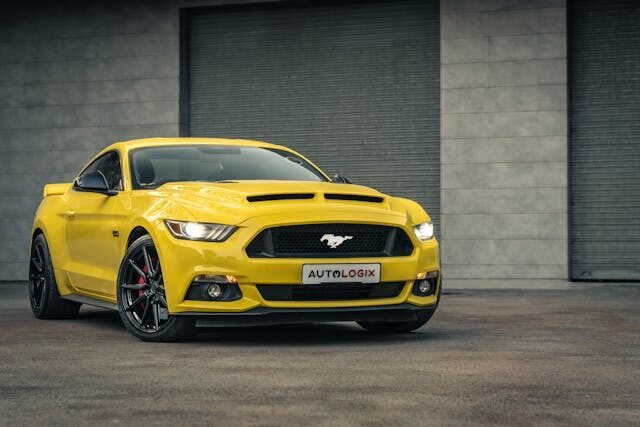Have you ever noticed that one side of your face or arm looks more aged than the other? If you spend significant time driving, you’re not imagining things. Your vehicle’s windows might be letting in more harmful radiation than you realize.
While most of us understand the importance of applying sunscreen before heading to the beach, we often overlook the daily UV exposure we receive simply by sitting in our cars. The truth is, ultraviolet radiation doesn’t take a break just because you’re inside your vehicle, and standard automotive glass offers surprisingly limited protection against these damaging rays.
Window tinting has emerged as one of the most effective solutions for protecting your skin from the cumulative effects of UV exposure during your daily commute and travels. Unlike temporary measures that require constant reapplication or remembering, professionally installed window tinting provides continuous, passive protection every time you get behind the wheel.
This isn’t just about comfort or aesthetics—it’s about safeguarding your long-term health. In this comprehensive guide, we’ll explore the science behind UV-related skin conditions, how window tinting technology works to block harmful rays, and why this simple modification could be one of the most important health decisions you make for yourself and your passengers.
Understanding UV Radiation and Its Impact on Skin Health
Before diving into solutions, let’s understand what we’re protecting ourselves against. Ultraviolet radiation is invisible electromagnetic energy emitted by the sun, and it reaches us constantly throughout the daylight hours—even on cloudy days and yes, even through your car windows.
The Two Types of UV Rays That Penetrate Your Vehicle
Not all UV radiation is created equal. UVB rays are the ones primarily responsible for sunburns and have traditionally received the most attention. These rays are partially blocked by standard automotive glass, particularly windshields. However, UVA rays tell a different story entirely. These longer wavelength rays penetrate deeply into your skin and pass through regular glass with alarming ease—up to 63% of UVA radiation can come straight through your untinted side and rear windows.
What makes UVA rays particularly insidious is their ability to penetrate deeper into your skin’s dermal layer, where they damage collagen, elastin, and other structural proteins. While UVB rays affect the skin’s surface, UVA rays work their damage from within, making their effects cumulative and often invisible until significant harm has already occurred. Think of UVA rays as the silent infiltrator—they don’t announce their presence with a sunburn, but they’re steadily working to break down your skin’s defenses day after day, mile after mile.
How UV Exposure Through Car Windows Damages Your Skin
Your time spent in the car adds up quickly. The average person spends about 300 hours per year driving, and for many professionals, this number doubles or triples. During all those hours, UV radiation is streaming through your windows, particularly on the driver’s side. Research has documented what dermatologists call “the left-side phenomenon”—drivers in countries where people drive on the right side of the road consistently show more photoaging, sun damage, and even skin cancers on the left side of their face and left arm.
The damage occurs at the cellular level. When UV radiation penetrates your skin, it creates free radicals—unstable molecules that damage DNA, proteins, and cell membranes. Your skin has natural repair mechanisms, but they can become overwhelmed with repeated exposure. Each day’s drive adds another layer of damage, and over years, this accumulation manifests as visible aging, texture changes, pigmentation irregularities, and potentially precancerous or cancerous lesions. The key word here is “cumulative”—it’s not any single drive that causes the problem, but rather the relentless, repetitive exposure that never gives your skin adequate time to fully repair itself.

The Science Behind Skin Conditions Caused by UV Rays
Understanding the specific skin conditions that result from UV exposure helps illustrate why protection matters so much. These aren’t merely cosmetic concerns—they represent genuine health issues that can impact your quality of life and, in some cases, become life-threatening.
Premature Aging and Photoaging from Vehicle UV Exposure
Photoaging refers specifically to aging caused by light exposure, and it accounts for up to 80% of visible facial aging. Unlike chronological aging, which happens gradually regardless of environmental factors, photoaging is entirely preventable. When UV rays penetrate your skin during your commute, they break down collagen and elastin—the proteins that keep your skin firm, smooth, and youthful-looking.
The signs of photoaging include deep wrinkles, especially around the eyes and mouth, rough skin texture, pronounced pores, and a leathery appearance to the skin. You might also notice that your skin has lost its elasticity and doesn’t “bounce back” the way it used to. One telltale sign of vehicle-related photoaging is asymmetrical aging, where one side of your face shows significantly more damage than the other. Studies have documented cases where drivers have visibly older-looking skin on their window side compared to the passenger side—a stark visual reminder of UV exposure’s cumulative effects.
Increased Risk of Skin Cancer from Daily Driving
This is where UV protection moves from cosmetic concern to medical imperative. Skin cancer is the most common cancer in the United States, with over 5 million cases treated annually. Both UVA and UVB rays are classified as carcinogens by health organizations worldwide. The same left-side phenomenon mentioned earlier extends to skin cancer rates—studies have found that in the United States, 53% of skin cancers occur on the left side of the body, corresponding to the driver’s side of the vehicle.
Melanoma, the deadliest form of skin cancer, has been directly linked to UV exposure patterns. While squamous cell carcinomas and basal cell carcinomas are more common and less aggressive, they still require medical treatment and can cause significant scarring. What many people don’t realize is that brief, repeated UV exposure—like your daily commute—can be just as damaging as longer, less frequent exposures. Your skin doesn’t differentiate between UV rays at the beach and UV rays during your morning drive; damage is damage, and it accumulates over time regardless of the setting.
Hyperpigmentation and Uneven Skin Tone Development
Have you noticed dark patches or spots appearing on your skin, particularly on areas exposed while driving? This condition, called hyperpigmentation, occurs when UV exposure triggers melanin overproduction in specific areas. Melasma, solar lentigines (commonly called sun spots or age spots), and post-inflammatory hyperpigmentation can all result from or be worsened by UV exposure through car windows.
These pigmentation changes aren’t just aesthetic issues—they’re visible markers of UV damage at the cellular level. When your skin produces excess melanin in response to UV exposure, it’s actually attempting to protect itself by creating a natural barrier. However, this protective mechanism often goes into overdrive, resulting in uneven, blotchy skin tone that can be difficult to correct even with professional treatments. People with darker skin tones are particularly susceptible to hyperpigmentation from UV exposure, though it affects people of all ethnicities. The frustrating aspect of vehicle-related hyperpigmentation is its preventability—with proper protection, these changes simply wouldn’t occur.
How Window Tinting Works as a UV Protection Barrier
Now that we understand the problem, let’s explore the solution. Window tinting technology has advanced significantly, and modern films offer sophisticated protection that goes far beyond the simple darkened glass of decades past.
The Technology Behind UV-Blocking Window Films
Window Tinting Riviera Beach works through multiple mechanisms to protect you from harmful radiation. Quality window films contain specialized compounds and layers designed specifically to absorb or reflect UV radiation before it penetrates the cabin of your vehicle. The most advanced films use nanotechnology, incorporating microscopic particles that interact with specific wavelengths of light.
The film itself typically consists of several layers working together. The adhesive layer bonds the film to your glass, while the tinting layer provides the visible light reduction. Most importantly, the UV-blocking layer contains compounds specifically engineered to intercept UV radiation. Some premium films include ceramic particles that provide superior UV protection without interfering with electronic signals (important for GPS, smartphones, and radio). These ceramic films represent the cutting edge of window tinting technology, offering the highest level of protection while maintaining excellent visibility and not creating the metallic sheen associated with older tinting technologies.
What’s remarkable about modern window tinting is its selectivity. These films can block up to 99.9% of UV radiation while still allowing visible light to pass through, meaning you maintain good visibility and don’t feel like you’re driving in darkness. This selective filtration is the key to effective window tinting—protecting you from what’s harmful while preserving what you need.
Percentage of UV Rays Blocked by Different Tint Levels
Understanding tint percentages can be confusing, but it’s simpler than it sounds. When you hear about “50% tint” or “35% tint,” that number refers to Visible Light Transmission (VLT)—the amount of visible light that passes through the film. A 50% tint allows 50% of visible light through, making it relatively light. A 35% tint is darker, allowing only 35% of visible light to pass.
Here’s what’s crucial to understand: the VLT percentage and UV-blocking capability are not the same thing. A quality window film at 50% VLT can still block 99% or more of UV radiation. This means you don’t have to choose between visibility and protection—you can have both. Even lighter tint that keep your windows relatively transparent provide excellent UV protection when manufactured with proper UV-blocking technology.
For maximum skin protection, experts recommend films that block at least 99% of both UVA and UVB rays. Most reputable manufacturers now offer films that meet or exceed this standard across their entire product range, regardless of darkness level. Line X Auto Spa, for instance, provides window tinting options that prioritize UV protection while allowing customers to choose the darkness level that suits their preferences and local regulations. The key takeaway is this: don’t sacrifice UV protection for aesthetics or visibility—with modern technology, you don’t have to.
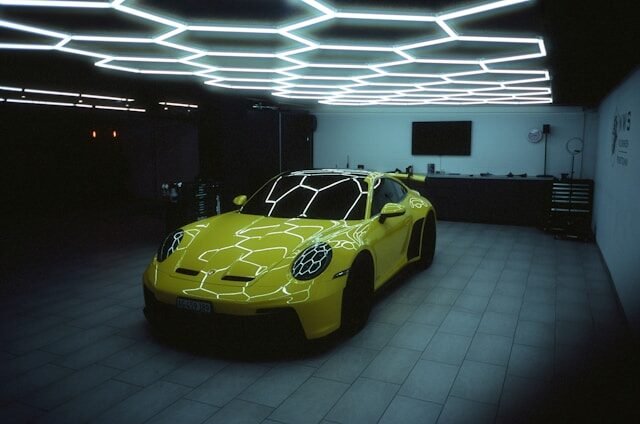
Medical Evidence Supporting Window Tinting for Skin Protection
The connection between window tinting and skin health isn’t just theoretical—it’s supported by substantial medical research and professional recommendations from dermatologists worldwide.
Dermatologist Recommendations for Vehicle UV Protection
The Skin Cancer Foundation explicitly recommends window tinting as an effective method for reducing UV exposure during driving. Dermatologists consistently advise their patients, particularly those with a history of skin cancer or precancerous lesions, to invest in UV-protective window film for their vehicles. This recommendation carries the same weight as advice to wear sunscreen and protective clothing.
Medical professionals emphasize that prevention is far more effective than treatment when it comes to UV-related skin damage. While sunscreen provides valuable protection, it requires consistent reapplication, can be forgotten, and doesn’t cover all exposed skin areas perfectly.
Window tinting, by contrast, provides set-it-and-forget-it protection that works every single time you’re in your vehicle. Dermatologists particularly stress window tinting’s importance for several groups: individuals with fair skin that burns easily, people with a personal or family history of skin cancer, those with photosensitive conditions, and anyone who spends significant time driving for work or leisure.
Studies Showing Reduced Skin Damage with Tinted Windows
Research published in medical journals has documented the protective effects of window tinting. Studies comparing UV exposure levels inside vehicles with and without tinting demonstrate dramatic differences. One significant study measured UV radiation levels inside vehicles and found that untinted side windows allowed approximately 63% of UVA radiation to penetrate, while vehicles with quality window tinting reduced this to less than 1%.
Long-term observational studies have also yielded compelling evidence. Researchers examining the prevalence of left-sided skin damage in drivers found that this asymmetric pattern of photoaging and skin cancer was significantly reduced in individuals who regularly drove vehicles with UV-protective window tinting. These studies controlled for other factors like sunscreen use and found that window tinting provided independent protective benefits. The medical evidence is clear: window tinting represents a legitimate, effective intervention for preventing UV-related skin conditions, not merely a comfort feature or aesthetic enhancement.
Additional Health Benefits of Window Tinting Beyond UV Protection
While UV protection represents the primary health benefit of window tinting, several additional advantages contribute to overall wellbeing during your time in the vehicle.
Temperature Regulation and Heat-Related Skin Issues
Excessive heat inside your vehicle doesn’t just make you uncomfortable—it can actually exacerbate certain skin conditions. People with rosacea, eczema, and other inflammatory skin conditions often experience flare-ups triggered by heat exposure. Window tinting significantly reduces the heat that enters your vehicle, potentially preventing these heat-related skin reactions.
Quality window films can reject up to 60% of solar heat, keeping your vehicle’s interior substantially cooler. This temperature regulation means your skin isn’t subjected to the stress of extreme heat fluctuations, which can trigger inflammation and worsen existing conditions. Additionally, cooler cabin temperatures mean less reliance on air conditioning, which can dry out your skin. The relationship between temperature control and skin health is often overlooked, but for people with temperature-sensitive skin conditions, the cooling effect of window tinting provides genuine therapeutic benefit beyond UV protection alone.
Glare Reduction and Eye Strain Prevention
The connection between eye health and skin health might not be immediately obvious, but they’re more related than you might think. Excessive glare forces you to squint repeatedly, which over time contributes to the development of crow’s feet and other wrinkles around the eyes. Window tinting reduces glare by filtering out the light wavelengths that cause that harsh brightness, allowing you to keep your eyes more relaxed while driving.
Furthermore, the eye area has the thinnest, most delicate skin on your entire body, making it particularly vulnerable to UV damage. The cumulative effect of squinting against glare combined with UV exposure accelerates aging around the eyes. By reducing both the UV radiation and the glare that causes squinting, window tinting addresses both aspects of this problem simultaneously. Your eyes feel more comfortable, you naturally squint less, and the delicate skin around your eyes receives better protection from the sun’s damaging rays.
Choosing the Right Window Tinting for Maximum Skin Protection
Not all window tint are created equal when it comes to health benefits. Understanding the options available helps you make an informed decision that prioritizes your skin protection.
Understanding Tint Percentages and UV Protection Ratings
As mentioned earlier, the darkness of your tint (VLT percentage) is separate from its UV-blocking capability, but both factors matter for practical purposes. You need to balance visibility, legal compliance, and UV protection. Most states have regulations governing how dark your window tint can be, typically focusing on the front side windows and windshield while allowing darker tint on rear windows.
When selecting window tinting, always ask about the specific UV protection rating, not just the darkness level. Look for films that block 99% or more of both UVA and UVB rays—this specification should be clearly documented by the manufacturer. Reputable installers will provide this information readily and can show you certification documents confirming the UV-blocking capabilities of their films.
It’s also worth considering the Skin Cancer Foundation’s Seal of Recommendation, which is awarded to window films that meet their strict criteria for UV protection. Products with this seal have undergone testing to verify their UV-blocking claims and represent a reliable choice for health-conscious consumers. Don’t hesitate to ask your window tinting provider whether their products carry this or similar certifications from recognized health organizations.
Ceramic vs. Traditional Tinting for Health Benefits
The window tinting market offers several types of films, but for health purposes, ceramic tinting stands out as the superior choice. Traditional dyed films provide basic UV protection and are the most economical option, but they can fade over time, potentially reducing their protective capabilities. Metalized films offer better durability and heat rejection but can interfere with electronic signals.
Ceramic window tinting represents the premium tier of protection. These films use non-conductive ceramic particles that provide exceptional UV blocking, superior heat rejection, and don’t interfere with your phone, GPS, or radio signals. Ceramic films also maintain their protective properties longer than dyed films, which means your investment in skin protection remains effective for years. While ceramic tinting costs more upfront, the superior health protection and longevity often make it the most cost-effective choice over the life of your vehicle.
Line X Auto Spa specializes in premium ceramic window tinting that prioritizes both UV protection and durability. When your goal is protecting your skin health, choosing the highest quality film available makes sense—after all, you’re investing in preventing potentially serious medical conditions, not just adding a cosmetic feature to your vehicle.
Real-World Impact: Who Benefits Most from Window Tinting
While everyone benefits from reduced UV exposure, certain groups gain particularly significant advantages from window tinting’s protective properties.
People who commute long distances daily face some of the highest cumulative UV exposure. If you spend an hour or more in your car each day, that’s hundreds of hours annually of UV exposure that window tinting can virtually eliminate. Professional drivers—including taxi drivers, rideshare drivers, delivery personnel, and sales representatives—fall into an even higher-risk category. Their occupational exposure to UV radiation through vehicle windows puts them at significantly elevated risk for asymmetric photoaging and left-sided skin cancers.
Individuals with fair skin that burns easily represent another high-priority group. People with skin types I and II (those who always or usually burn and rarely or never tan) are particularly vulnerable to UV damage. For these individuals, every measure of UV protection matters significantly. Similarly, people with a personal or family history of skin cancer should consider window tinting an essential preventive measure, not an optional enhancement.
Parents of young children also benefit enormously from window tinting. Children’s skin is more vulnerable to UV damage than adult skin, and early-life sun exposure significantly increases lifetime skin cancer risk. Protecting your children during car rides—to school, sports practices, family trips—contributes meaningfully to their long-term skin health. Think of window tinting as a health investment for your entire family, providing passive protection that doesn’t require remembering to apply sunscreen before every car ride.
Maintenance and Longevity of UV-Protective Window Tinting
An often-overlooked aspect of window tinting is its remarkable longevity and minimal maintenance requirements, making it one of the most practical health interventions you can implement.
Quality window film, when professionally installed, typically lasts 10-15 years or longer without requiring replacement. During this entire period, it continues providing consistent UV protection day after day. This durability means that window tinting offers exceptional value compared to other UV protection methods that require ongoing purchases or applications. Consider that you’d need to buy sunscreen repeatedly over that same 10-15 year period, and even then, you’d need to remember to apply it consistently before every drive—something most people don’t do.
Maintaining your window tinting is straightforward. Clean your tinted windows with a soft cloth and mild, ammonia-free cleaner. Avoid abrasive materials that could scratch the film’s surface. That’s essentially the entire maintenance routine. The film doesn’t require reapplication, doesn’t degrade significantly in normal use, and continues protecting you automatically every time you’re in your vehicle.
Over time, you should monitor your window tinting for signs of wear, such as bubbling, peeling at the edges, or fading (particularly with dyed films). These issues typically indicate that the film has reached the end of its lifespan and should be replaced to maintain optimal UV protection. However, with quality ceramic films professionally installed, these issues are rare within the typical lifespan of vehicle ownership.
Line X Auto Spa Serving the Admiral’s Cove and Beyond in Jupiter, FL
Line X Auto Spa is dedicated to serving the diverse needs of the local community of Jupiter, FL, Including individuals residing in neighborhood like Admiral’s Cove With its convenient location near landmarks such as the “The Club at Admirals Cove, Admirals Cove Gatehouse “major intersections like “Admiral’s Cove Blvd & A1A and Admiral’s Cove Gatehouse & Admiral’s Cove Blvd” (coordinates: 26.91106190073984, -80.0920931) We offer Window tinting services.
Get Window Tinting Services at Admiral’s Cove Now
Navigate from Admiral’s Cove to Line X Auto Spa
How Window Tinting Protect Skin from UV Rays?
- UV Radiation Penetration Through Vehicle Glass:
- Standard automotive side windows (tempered glass) can transmit up to 79% of UVA rays, which penetrate deeply and cause skin aging and cancer.
- Laminated windshields block about 98% of UVA rays, offering better protection.
- Both types block nearly 100% of UVB rays, which cause sunburn.
- Effectiveness of Window Tinting:
- Clear or tinted window films reduce total UV radiation penetration by over 99%, dramatically lowering skin cancer risk.
- Professional automotive window tint blocks up to 99.9% of UVA and UVB rays.
- Window tinting is recommended especially for drivers and passengers spending extended time in vehicles, as UVA exposure accumulates silently over years.
- Health Impact:
- UVA rays cause DNA damage linked to melanoma and nonmelanoma skin cancers.
- Studies show higher skin cancer rates and premature aging on the left side of drivers’ faces due to unprotected window exposure.
- Window tinting acts as a medical-grade sun protection barrier, comparable to SPF 50+ sunscreen.
- Visual Data (suggested charts for slide):
- Bar chart comparing UVA transmission rates:
- Laminated windshield: 2% UVA transmission
- Untinted tempered side window: 79% UVA transmission
- Tinted window film applied: <1% UVA transmission
- Pie chart showing UV radiation composition reaching skin inside vehicle:
- UVA: 95%
- UVB: 5% (mostly blocked by glass)
- Infographic of left vs right side skin damage on drivers’ faces illustrating asymmetrical UV exposure.
- Bar chart comparing UVA transmission rates:
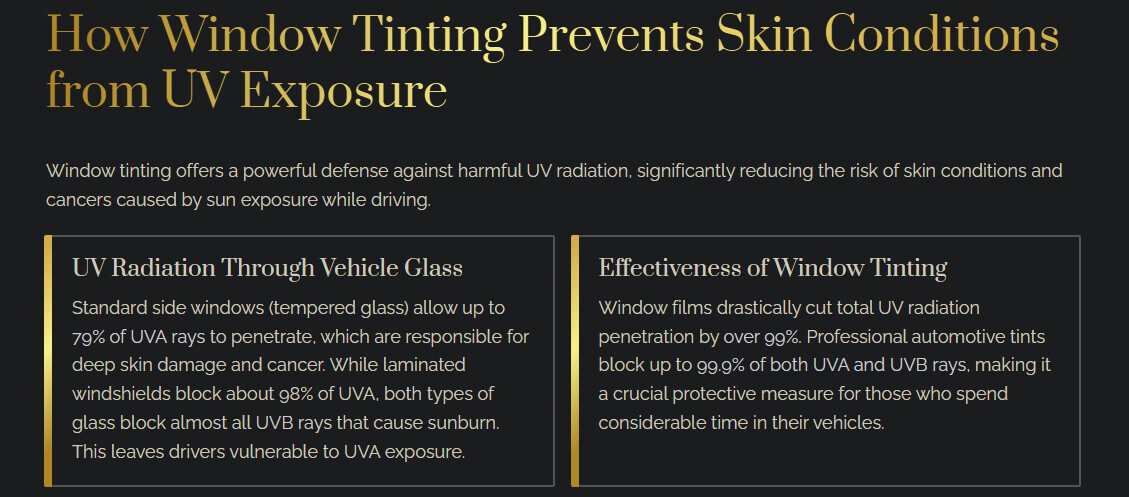
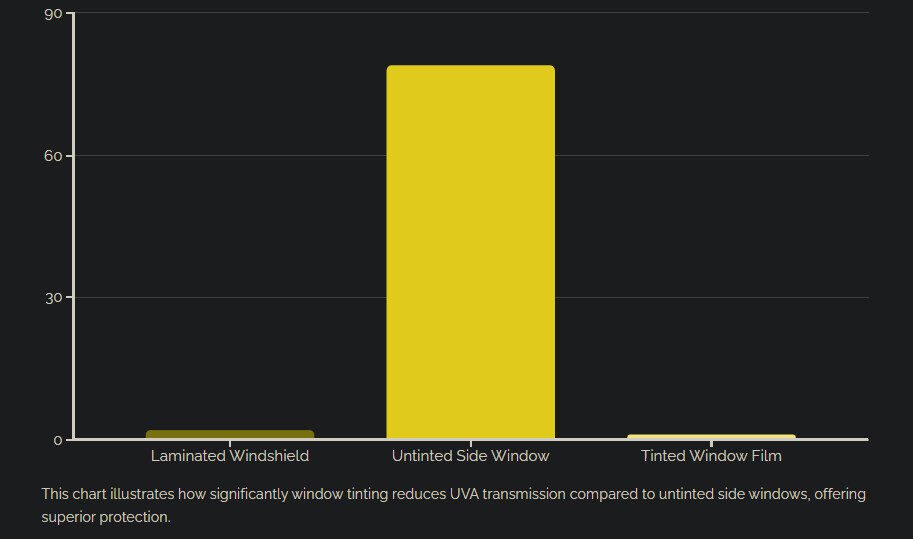
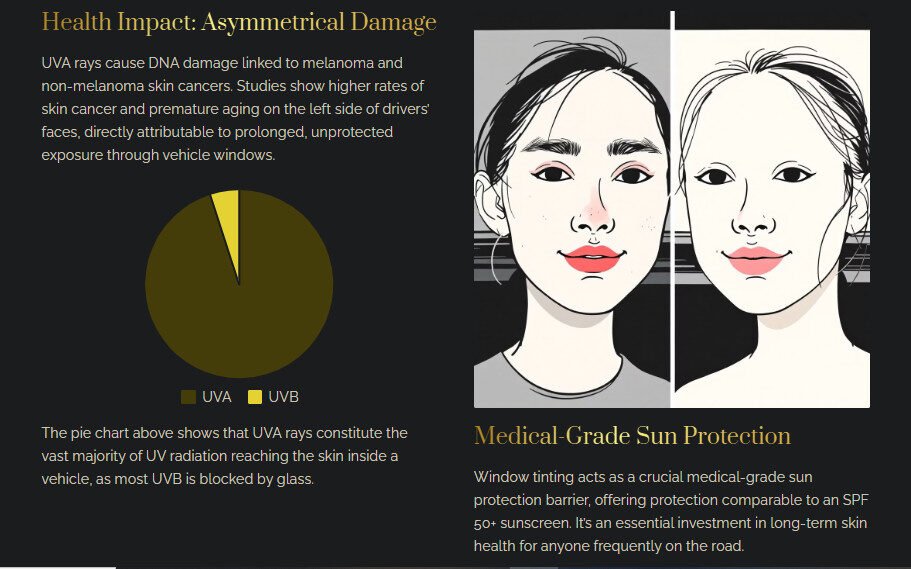
Sources: Cancer Council Australia (2025), Skin Cancer Foundation (2025), Accutint NW (2025), Kaloko Tinting (2025)
Protecting your skin from UV exposure shouldn’t end when you step out of the sun and into your vehicle. Standard automotive glass provides insufficient protection against UVA rays, leaving you vulnerable to cumulative damage that manifests as premature aging, hyperpigmentation, and increased skin cancer risk. Window tinting offers a practical, effective, and long-lasting solution to this often-overlooked health concern.
The medical evidence supporting window tinting for skin protection is compelling. Dermatologists recommend it, research demonstrates its effectiveness, and real-world observations confirm that it prevents the asymmetric photoaging and skin damage common among frequent drivers. By blocking up to 99.9% of UV radiation, quality window films provide passive protection that works every time you’re in your vehicle, without requiring any effort or memory on your part. Whether you commute daily, drive professionally, have fair or photosensitive skin, or simply want to protect yourself and your passengers from unnecessary UV exposure, window tinting represents a worthwhile investment in long-term skin health. The technology has advanced to the point where you don’t have to sacrifice visibility or aesthetics for protection—modern films deliver both. Your skin endures enough environmental stressors without adding hours of preventable UV exposure during your time on the road. Taking action to protect it makes sense not just from a health perspective, but as a practical decision that pays dividends for years to come.
FAQs
How much UV protection does regular automotive glass provide without tinting?
Standard automotive glass provides limited UV protection, with significant variation between different windows in your vehicle. Windshields typically block about 96% of UVA rays because they’re made with laminated glass containing a plastic layer. However, side and rear windows, which are usually made of tempered glass, allow approximately 63% of UVA radiation to pass through. This means that while you’re relatively protected from UV exposure through your windshield, your side windows expose you to substantial UV radiation during driving. UVB rays are largely blocked by all automotive glass, but since UVA rays cause the majority of cumulative skin damage, this partial protection is insufficient for preventing photoaging and skin cancer risk.
Will window tinting completely eliminate my need for sunscreen while driving?
While window tinting dramatically reduces UV exposure in your vehicle, it shouldn’t be viewed as a complete replacement for sunscreen in all circumstances. Quality window tinting blocks 99% or more of UV radiation coming through your side and rear windows, providing excellent protection for your arms, face, and any other exposed skin. However, your windshield area still allows some UV penetration, and if you drive with windows down or have a sunroof, you’ll still receive exposure. The most comprehensive approach combines window tinting with occasional sunscreen application, especially for longer drives or if you’re particularly sun-sensitive. Think of window tinting as your primary defense that works automatically, with sunscreen serving as backup protection for any gaps.
Does the darkness level of window tint affect its UV protection capabilities?
This is a common misconception—the darkness of window tint (measured as Visible Light Transmission percentage) is actually independent of its UV-blocking capability. A relatively light tint at 50% VLT can provide the same 99.9% UV protection as a much darker 20% tint, provided both films are manufactured with proper UV-blocking technology. The darkness primarily affects how much visible light passes through, influencing factors like privacy, heat rejection, and aesthetics. When shopping for window tinting specifically for health benefits, focus on the UV protection specification (should be 99% or higher for both UVA and UVB) rather than assuming darker tint provide better protection. This allows you to choose a darkness level that meets legal requirements and your visibility preferences while still maximizing skin protection.
How long does professionally installed window tinting maintain its UV-protective properties?
Quality window film professionally installed maintains its UV-blocking capabilities for the entire lifespan of the film, typically 10-15 years or longer. Unlike sunscreen that degrades quickly or clothing that loses UV protection after repeated washing, window tinting’s UV-blocking properties don’t diminish significantly over time when properly maintained. Ceramic films, in particular, offer exceptional longevity because the UV-blocking compounds are integrated throughout the film structure rather than just surface coatings. The main factors that affect lifespan are installation quality and maintenance—films that are scratched, improperly cleaned with ammonia-based products, or poorly installed may deteriorate faster. However, under normal use with proper care, you can expect consistent UV protection throughout your vehicle ownership period without needing replacement solely for health protection purposes.
Can window tinting help with existing skin damage, or does it only prevent new damage?
Window tinting functions as a preventive measure rather than a treatment for existing skin damage. Once photoaging, hyperpigmentation, or precancerous changes have occurred, window tinting won’t reverse those conditions—you’d need dermatological treatments for that. However, preventing additional UV exposure is crucial for anyone with existing skin damage because continued UV exposure worsens these conditions and increases the likelihood of new damage developing. Think of window tinting as stopping the clock on further UV-related damage while you pursue treatments for existing issues. For people with a history of skin cancer or precancerous lesions, dermatologists often recommend window tinting as part of a comprehensive sun protection strategy to reduce recurrence risk. The film protects your skin as it heals and prevents the accumulation of additional damage that could undermine dermatological treatments.
Our Other Blog Posts Related Window Tinting
Learn How Window Tinting Reduce Glare on In-Vehicle Screens
How Window Tinting Enhance Driving Safety in Rain & Fog
How Window Tinting Boosts Energy Efficiency in Electric Vehicles
Window Tinting Heat Reduction | Keep Your Car Cool & Protected
Window Tinting in Hot Climates Explained | Line X Auto Spa Riviera Beach
